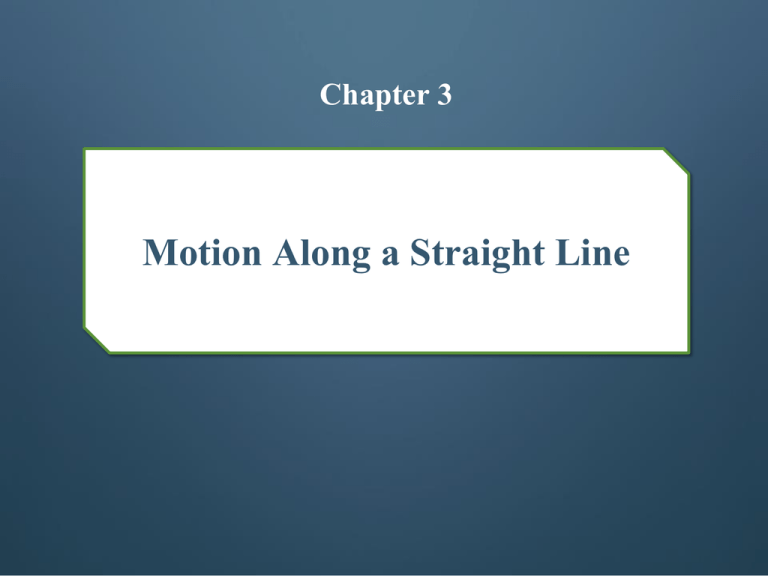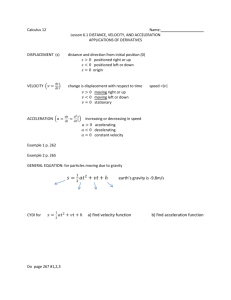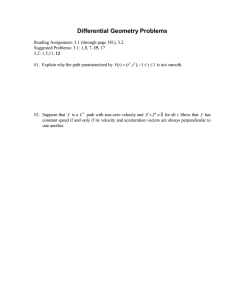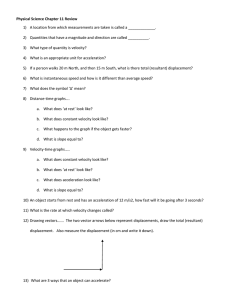
Chapter 3
Motion Along a Straight Line
Position, Displacement, and Average Velocity
Kinematics is the classification and comparison of motions
For this chapter, we restrict motion in three ways:
1. We consider motion along a straight line only
2. We discuss only the motion itself, not the forces that
cause it
3. We consider the moving object to be a particle
A particle is either:
A point-like object (such as an electron)
Or an object that moves such that each part travels in the
same direction at the same rate (no rotation or stretching)
Position, Displacement, and Average Velocity
Position is measured relative to a reference point:
o
The origin, or zero point, of an axis
Position has a sign:
o
Positive direction is in the direction of increasing numbers
o
Negative direction is opposite the positive
Figure 2-1
Position, Displacement, and Average Velocity
A change in position is called displacement
o
∆x is the change in x, (final position) – (initial position)
Displacement: is the displacement vector which represent the change
in the position vector.
∆𝒓 = 𝒓𝟐 − 𝒓𝟏
Or can written
∆𝒙 = 𝒙𝟐 − 𝒙𝟏
Examples: A particle moves . . .
o
From x = 5 m to x = 12 m: ∆x = 7 m (positive direction)
o
From x = 5 m to x = 1 m: ∆x = -4 m (negative direction)
o
From x = 5 m to x = 200 m to x = 5 m: ∆x = 0 m
The actual distance covered is irrelevant
Eq. (2-1)
Position, Displacement, and Average Velocity
The difference between Distance and Displacement:
Distance is a scalar quantity representing the interval between two
points.
It
is
just
the
magnitude
of
the
interval.
However, Displacement is a vector quantity and can be defined by using
distance concept. It can be defined as distance between the initial point
and final point of an object. It must be the shortest interval connecting
the initial and final points, that is a straight line. Let’s look at the below
examples for deep understanding.
Position, Displacement, and Average Velocity
Displacement is therefore a vector quantity
o
Direction: along a single axis, given by sign (+ or -)
o
Magnitude: length or distance, in this case meters or feet
Ignoring sign, we get its magnitude (absolute value)
o
The magnitude of ∆x = -4 m is 4 m.
Answer: pairs (b) and (c)
(b) -7 m – -3 m = -4 m
(c) -3 m – 7 m = -10 m
Position, Displacement, and Average Velocity
Average velocity is the ratio of:
o
A displacement, ∆x
o
To the time interval in which the displacement occurred, ∆t
Eq. (2-2)
Average velocity has units of (distance) / (time)
o
Meters per second, m/s
Position, Displacement, and Average Velocity
On a graph of x vs. t, the average velocity is the slope of the
straight line that connects two points
Average velocity is therefore a vector quantity
o
Positive slope means positive average velocity
o
Negative slope means negative average velocity
Figure 2-4
Position, Displacement, and Average Velocity
Average speed is the ratio of:
o
The total distance covered
o
To the time interval in which the distance was covered, ∆t
Eq. (2-3)
Average speed is always positive (no direction)
Example: A particle moves from x = 3 m to x = -3 m in 2
seconds.
o
Average velocity = -3 m/s; average speed = 3 m/s
Instantaneous Velocity and Speed
Instantaneous velocity, or just velocity, v, is:
o
At a single moment in time
o
Obtained from average velocity by shrinking ∆t
o
o
The slope of the position-time curve for a particle at an instant (the
derivative of position)
A vector quantity with units (distance) / (time)
•
The sign of the velocity represents its direction
Eq. (2-4)
Instantaneous Velocity and Speed
Speed is the magnitude of (instantaneous) velocity
Example: A velocity of 5 m/s and -5 m/s both have an
associated speed of 5 m/s.
Answers:
(a) Situations 1 and 4 (zero)
(b) Situations 2 and 3
Position, Displacement, and Average Velocity
Example 1: What is the speed of a cheetah that travels 120 meters in 4 seconds?
Solution:
𝑆𝑝𝑒𝑒𝑑 =
𝑑
𝑡
=
120
4
= 30
𝑚
𝑠
Example 2: A bicyclist travels 60.0 kilometers in 3.5 hours. What is the cyclist’s average speed?
(H.W)
Example 3: What is the velocity of a car that travels 100.0 meters, northeast in 4.65 seconds?
Solution:
𝑣𝑒𝑟𝑎𝑔𝑒 𝑠𝑝𝑒𝑒𝑑 =
𝑇𝑜𝑡𝑎𝑙 𝑑𝑖𝑠𝑡𝑎𝑛𝑐𝑒 𝑡𝑟𝑎𝑣𝑒𝑙𝑒𝑑
𝑇𝑖𝑚𝑒 𝑡𝑎𝑘𝑒𝑛
100
= 4.65 = 21.5
𝑚
𝑠
The velocity of the car is 21.5 meters per second, northeast.
Example 4 : Displacement, Distance, Speed and Velocity.
Adam walks 9 m north then 9 meters south in a total of 14 seconds.
He travels a distance of 9 + 9 = 18 m.
His displacement is +9 –9 = 0 m.
His average speed is 𝑠 =
𝑑
𝑡
18
= 14 = 1.29 𝑚. 𝑠 −1
𝑠
0
His average velocity is 𝑣 = 𝑡 = 14 = 0 𝑚. 𝑠 −1
Position, Displacement, and Average Velocity
Example 5: A bicycle moves along x-axis according to the function 𝒙 𝒕 = 𝟑𝒕𝟐 + 𝟓 find:
1)
2)
3)
4)
The distance travelled by the bicycle in 2 seconds.
The average velocity in the interval 𝑡 = 2 𝑠 and 𝑡 = 4 𝑠.
The speed of the bicycle at 𝑡 = 3 𝑠.
The acceleration at 𝑡 = 3 𝑠.
Solution:
1) 𝑥 𝑡 = 3𝑡 2 + 5 = 3(2)2 + 5 = 17 𝑚
2) 𝑣 =
∆𝑥
∆𝑡
=
𝑥2 −𝑥1
𝑡2 −𝑡1
𝑥 𝑡 = 2 𝑠 = 3𝑡 2 + 5 = 3(2)2 + 5 = 17 𝑚
𝑥 𝑡 = 4 𝑠 = 3𝑡 2 + 5 = 3(4)2 + 5 = 53 𝑚
∴ 𝑻𝒉𝒆 𝒂𝒗𝒆𝒓𝒂𝒈𝒆 𝒔𝒑𝒆𝒆𝒅 𝒊𝒔
𝑣=
3) 𝑣 =
4) 𝑎 =
∆𝑥
∆𝑡
𝑑𝑥
𝑑𝑡
𝑑𝑣
𝑑𝑡
=
𝑥2 −𝑥1
𝑡2 −𝑡1
=
53−17
4−2
=
36
2
= 18
𝑚
𝑠
= 6𝑡 𝑎𝑡 𝒕 = 𝟑 𝒔 ⟹ 𝑣 = 6 × 3 = 18
=6 ⟹𝑎=6
𝑚
𝑚2
𝑚
𝑠
Acceleration
A change in a particle's velocity is acceleration
Average acceleration over a time interval ∆t is
Eq. (2-7)
Instantaneous acceleration (or just acceleration), a, for a
single moment in time is:
o
Slope of velocity vs. time graph
Eq. (2-8)
Acceleration
Combining Eqs. 2-8 and 2-4:
Eq. (2-9)
Acceleration is a vector quantity:
o
Positive sign means in the positive coordinate direction
o
Negative sign means the opposite
o
Units of (distance) / (time squared)
Acceleration
Example 1: Determining Average Speed Your dog runs in a straight line for a distance of 43 m in
28 s. What is your dog’s average speed? (H.W)
Example 2: Calculate the acceleration of a car that travels from 0 m/s to 28 m/s in 10 seconds.
Solution:
𝑎𝑎𝑣𝑒 =
𝑉𝑓 −𝑉𝑖
𝑇
=
28−0
10
= 2.8
𝑚
𝑠2
Acceleration
Example If a car with velocity v = -25 m/s is braked to a stop
in 5.0 s, then a = + 5.0 m/s2. Acceleration is positive, but
speed has decreased.
Note: accelerations can be expressed in units of g
Eq. (2-10)
Answers:
(a) + (b) - (c) - (d) +
Motion with constant Acceleration :
Kinematic Equations for Motion a Particle Under Constant Acceleration
Equation No.
Equation
Information Given by Equation
1
Velocity as a function of time
3
Position as a function of time
4
Velocity as a function of Position
Example 1: A jet lands on an aircraft carrier at 𝟏𝟒𝟎
𝒎𝒊
𝒉
≈ 𝟔𝟑
𝒎
𝒔
. Find:
1) What is its acceleration (assumed constant) if it stops in 𝟐. 𝟎 𝒔 due to an arresting cable that snags the
jet and brings it to a stop?
Solution:
Use equation 1
𝑎𝑥 =
𝑣𝑥𝑓 −𝑣𝑥𝑖
𝑡
=
𝑚
𝑠
0−63
2.0 𝑠
= −32
𝑚
𝑠2
2) If the jet touches down at position 𝒙𝒊 = 𝟎, what is its final position .
Solution:
Use equation 2 to solve for final position
𝑥𝑓 = 𝑥𝑖 + 12 𝑣𝑥𝑖 + 𝑣𝑥𝑓 . 𝑡 = 0 +
1
2
63
𝑚
𝑠
+ 0 . 2.0 𝑠 = 63 𝑚
Free-Fall Acceleration
Free Fall Acceleration:
Falling Objects:
In the absence of air resistance, all objects
fall with the same acceleration, although
this may be hard to tell by testing in an
environment where there is air resistance.
One important example of constant
acceleration is the “free fall” of an object
under
the influence of the Earth’s gravity. The
picture shows an apple and a feather
falling in vacuum with identical motions.
Figure 2-12
Free-Fall Acceleration
Free-fall acceleration is the rate at which an object
accelerates downward in the absence of air resistance
o
Varies with latitude and elevation
o
Written as g, standard value of 9.8 m/s2
o
Independent of the properties of the object (mass, density,
shape, see Figure 2-12)
The equations of motion in Table 2-1 apply to objects in
free-fall near Earth's surface
o
In vertical flight (along the y axis)
o
Where air resistance can be neglected
Free-Fall Acceleration
The free-fall acceleration is downward (-y direction)
o
Value -g in the constant acceleration equations
Answers:
(a) The sign is positive (the ball moves upward); (b) The sign is negative (the ball
moves downward); (c) The ball's acceleration is always -9.8 m/s2 at all points
along its trajectory
Free-Fall Acceleration
𝒎
𝒂 = −𝒈 = −𝟗. 𝟖 𝟐
𝒔
Free-Fall Acceleration
Example 1: A stone is dropped from rest from the top of a building, as shown in the Figure.
After 3s of free fall, what is the displacement y of the stone?
Solution:
From equation
𝑦𝑓 = 𝑦𝑖 + 𝑣𝑥𝑖 .𝑡 − 12.𝑔.𝑡 2
𝑦𝑓 = 0 + 0 − 12. 9.8 . 32 = −44.1 𝑚
Free-Fall Acceleration
Example 2: A student throws a set of keys vertically upward to another student in a
window 4m above as shown in the Figure. The keys are caught 1.5 s later by the
student.
1) With what initial velocity were the keys thrown?
2) What was the velocity of the keys just before they were caught?
Solution:
1) Let 𝒚𝒐 = 0 and y = 4m at t = 1.5s then we find
𝑦 = 𝑦𝑜 + 𝑣𝑜 . 𝑡 − 12. 𝑔. 𝑡 2
4 = 0 + 𝑣𝑜 . 1.5 − 12. (9.8). (1.5)2
𝑣𝑜 = 10
𝑚
𝑠
2) The velocity at any time 𝒕 > 𝟎 is given by
𝑣 = 𝒗𝒐 − 𝑔𝑡 ⇒ 𝑣 = 10 − 9.8 . 1.5 = −4.68 𝑚/𝑠
Summary
Position
Displacement
Relative to origin
Positive and negative
directions
Eq. (2-1)
Average Velocity
Change in position (vector)
Average Speed
Displacement / time (vector)
Eq. (2-2)
Distance traveled / time
Eq. (2-3)
Summary
Instantaneous Velocity
At a moment in time
Speed is its magnitude
Average Acceleration
Eq. (2-7)
Eq. (2-4)
Instantaneous Acceleration
First derivative of velocity
Second derivative of position
Eq. (2-8)
Ratio of change in velocity to
change in time
Constant Acceleration
Includes free-fall, where
a = -g along the vertical axis
Tab. (2-1)
HW
HW #
14, 15 , 25 , 26 , 27 ,28 , 33 , 60 , 64
© 2014 John Wiley & Sons, Inc. All rights reserved.





